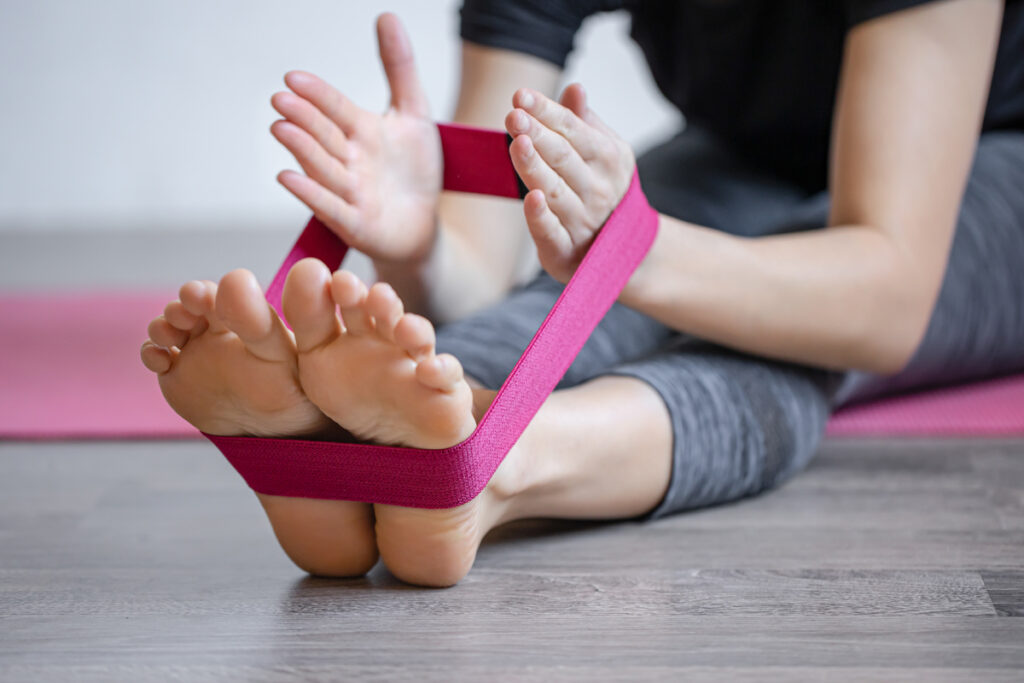Can you build muscle mass just as quickly with elastic bands and your body weight compared to a barbell or dumbbell?
During COVID, many athletes were forced to train with elastics. How effective is this? Researchers compared traditional strength training with training with elastic bands and your body weight. Can you build just as much muscle mass without extra weights?
Difference from biomechanics
Before we discuss the research, first, a bit of training theory to clarify the differences between the two methods: training with a barbell or dumbbell has a different load profile than training with an elastic band. Just think about stretching an elastic band further and further. You get more and more resistance.
This is very different with a barbell, where the resistance remains the same, but only the position of your joints changes.
You now know that the resistance of an elastic increases as you add more length. For example, consider the pull-up with an elastic band that stretches you from the knee downwards (see the right image above). You will have the most help at the bottom, and you will have to do everything yourself at the top. This is a different load profile than a regular pull-up or a lat pulldown (see the left image above), where you constantly have the same resistance.
Conversely, you also see that a banded push-up with elastic becomes the most challenging when fully extended. This makes it impossible to have the same tension on the muscles at the bottom compared to the top of the push-up position. Fortunately, we know that you can build muscle mass from approximately 30% of your maximum strength. This means that you can, for example, train your chest muscles and, especially the triceps, with banded push-ups, provided you have the right elastics for your level.
What does research indicate?

What is the difference between elastic bands and traditional strength training? Japanese researchers collected athletes between the ages of 30 and 64. Half of these were randomly assigned to a group that performed exercises with traditional strength training (TD) (n = 21) and the remainder to a group that trained with body weight and elastics (ELA) (n = 16).
Both groups performed full-body exercises twice a week for 8 weeks. The group with TD had a workout with squats, bench presses, deadlifts, dumbbell rows, and back extensions. These were performed at 70% of their 1rm, with three sets of 8-12 repetitions per exercise.
The other group trained in the following exercises: leg raises, body weight squats, back raise, shoulder overhead mobility exercises, rowing, dips, lunges, one-legged Romanian deadlifts, and push-ups for muscle failure. Using an MRI scan of the mid-thigh, images were taken before and after training to analyze the difference. The cross-sectional area (CSA) of the muscle and fat stores (IMF content) in the quadriceps femoris were measured from the images.
Was there a visible difference?
Both groups showed significantly increased muscle cross-sectional area after training (TD, P = 0.001; ELA, P = 0.002). It was also noticeable that the amount of fat in the thigh did decrease with the TD (P = 0.036), but this did not change significantly with the ELA (P = 0.076). These results suggest that both resistance training with TD and ELA can induce muscle growth. However, fat storage is different between the two groups.
Does this mean that training with elastic bands and body weight is just as effective as traditional strength training? Maybe because this study has a number of snags. There are arguments for and against.
Argument no difference: if you make it challenging enough and are creative, there is always an angle of movement that you can come up with that challenges the muscles enough. For example, consider a weighted handstand push-up with 30 kilograms. It is just as heavy as a very heavy military press. Of course, it is a different exercise pattern with more stability, but the difference in muscle growth will be minimal.
There is a difference because there are always a number of comments to be made. Firstly, they are novice athletes and not experienced powerlifters who need a completely different load to grow.

It was also noticeable that the group that already did TD was a lot stronger than the ELA group. This means that the TD group may have had more experience and less growth potential because much more of the newbie gains had already been utilized than the ELA group. Future research should show this with groups with the same starting point. Just think back to your training period when you first started exercising. The steps you took then were gigantic compared to 10 years later. It is, therefore, possible that the training effect of the bodyweight group is overestimated because the athletes are less experienced.
Conclusion: traditional strength training is still preferred for effective muscle building. Especially because you can get stronger more easily and need less creativity; however, this does not mean that it is not possible with elastics. Think of tuners at the Olympic level. Or calisthenics athletes who compete at the top. These athletes should not have to feel ashamed in a natural bodybuilding competition. Also, keep in mind that both calisthenics athletes and high-level gymnasts also do strength training in addition to their sport-specific exercises.
And what about experienced strength athletes?
What about experienced powerlifters? Can they maintain their strength with bands and a lot of creativity?
Probably retention of 90-100% of muscle mass over 1-3 months. By being very creative, you can make squats, lunges, and push-ups very difficult. Just think of single-leg banded squats or banded push-ups alternating with explosive push-ups.
But this is different for strength.
Strength is a skill.
If you want to become stronger, you have to practice this. To give you an example, during COVID, I had the opportunity to squat with up to 250 pounds. After a few weeks of training, I was able to do sets of 30 repetitions. Super tiring and challenging. When COVID was over, and I could train in the gym again with heavier weights, I had to get used to weights above 150 kilograms for a few weeks. I was no longer used to lifting this. It took some getting used to being under it. The theory behind this is that the body adapts to the exercise profile. If you don’t lift heavy, you will lose that skill after a few weeks or months.







GIPHY App Key not set. Please check settings